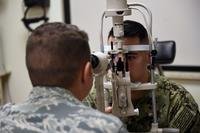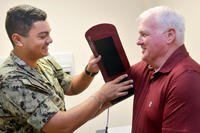 MILITARY UPDATE: First 'Choice Cards' Mailed to 320,000 Vets Living Far from VA Care
MILITARY UPDATE: First 'Choice Cards' Mailed to 320,000 Vets Living Far from VA Care
The Department of Veterans Affairs has mailed its first medical “Choice Cards,” with letters explaining how to use them, to 320,000 VA-enrolled veterans who reside more than 40 miles from any type of VA medical facility.
By late November, another 370,000 vets, those facing waits longer than 30 days for VA appointments, will be the second group to get the cards, said Dr. James Tuchschmidt, VA’s acting principal deputy under secretary for health.
These are the two groups of vets eligible immediately to use information on their Choice Card to try to secure more convenient or timely care than VA can provide. By the end of January another 8 million enrolled veterans also will receive Choice Cards. These vets, however, won’t be eligible to use them to access non-VA care unless they move beyond 40 miles of a VA-owned medical facility or VA can’t provide care within 30 days. The 30-day window is based on a veteran’s preferred date to get care or the date deemed medically necessary by their physicians.
To receive a Choice Card, veterans must have been enrolled in VA health care by Aug. 1, 2014. Those who have enrolled later are eligible only if they served on active duty in a theater of combat operations in the previous five years.
As vet advocacy groups have cautioned for months, the Choice Card is not a golden key to unlimited health care from any physician or facility a veteran might choose, despite what some lawmakers touted last summer while making it the featured item of the Veterans Access, Choice and Accountability Act of 2014.
“It is important to know that the Choice Card does not provide guaranteed health care coverage or an unlimited medical benefit,” explains VA Secretary Robert McDonald in a letter to the first card recipients. “In fact, before your Choice Card for this benefit can be used, your eligibility must be verified and you must receive advance authorization from VA.”
The card itself is similar to most health insurance cards, with the holder’s name shown and a number to call to verify eligibility for outside care. Authorization to use it must be cleared by a program manager for every episode of care.
Those authorized to seek outside care can choose from a network of VA-approved providers or their own providers, if VA approved. To be approved, they must treat Medicare patients and accept Medicare rates or work at a Department of Defense or Indian Health Service facility or in a federally qualified health center.
“They also have to have a valid license to practice,” said Tuchschmidt. “We put that stuff in there to make sure that the people we are engaging to see veteran patients are actually qualified to see them.”
Angry at the discovery of systemic patient wait-time abuses across the VA health system last spring, Congress gave VA only 90 days to establish the Choice Card program as a way to guarantee more timely and convenient access to care.
The deadline left VA with no alternative to getting the program launched without partnering with two current contractors -- TriWest Healthcare Alliance of Phoenix, Ariz., and HealthNet Federal Services of Arlington, Va. Both already run VA Patient-Centered Community Care (PC3) networks, which backstop VA health care with networks of primary and specialty care providers. The contracts swiftly were modified to include operation of the Choice Card program and expansion of provider networks and telephone call centers to meet significantly heavier demand.
Providers in the TriWest and HealthNet networks already are pre-screened and certify that they will meet VA measures for timeliness and quality of care, and will transfer medical records promptly back to VA to ensure continuity of care.
Though the law required cards to be mailed to every eligible enrolled veteran by Nov. 5, VA officials opted for a phased rollout to avoid any program crash.
“It just didn’t make sense to mail cards to almost nine million veterans and try to build a telephone call center [large enough to answer all] those calls and questions,” Tuchschmidt said. “It would have been inundated and [also] extraordinarily expensive for a vendor to build that surge capacity.”
So VA choose to send cards first to veterans with mailing addresses more than 40 miles from a VA health facility. In about two weeks, after TriWest and HealthNet have handled the bulk of those calls by verifying eligibility, screening providers and making appointments within a five-day goal, the contractors will begin to process card usage by veterans facing long delays for VA care.
Tuchschmidt noted that the VA medical system continues its stepped-up effort since May to get as many patients as possible off waiting lists and into VA care. VA had 1.2 million more patient visits in fiscal 2014 than a year earlier, he said, with 500,000 patients seen on weekends and evenings. Also, while awaiting full implementation of Choice Card, many patients facing long waits will be referred to private sector care under previous VA authorities.
Last month, as the new law required, VA also streamlined how it pays for outside hospital care and medical services delivered by non-VA providers.
Choice Card is to end in three years or whenever VA spends all of the $10 billion set aside to fund it. Tuchschmidt predicts that the money won’t run out before card program expires in late 2017.
Veterans will find quirks in the how the law or VA’s interpretation impacts eligibility. For example, the law’s 40-mile rule is based on distance to any VA health facility regardless of size or services offered. So if a veteran needs routine care from a cardiologist, and lives 100 miles from the nearest VA cardiologist but within 40 miles of a small VA clinic, the clinic’s location will disqualify the veteran from using Choice Card to get private cardiology care.
Also, VA interprets the 40 miles to be a “straight line” distance, not driving distance. That means a veteran won’t be able to use outside care if the VA hospital is within 40 miles “as the crow flies” however long it takes to reach by car.
VA leases but doesn’t own medical facilities in Alaska or Hawaii which means almost all veterans living there can use Choice Card to get private sector care if they choose, Tuchschmidt said. VA also doesn’t run any health facilities in New Hampshire. Vets who reside there can use the card unless they live within 20 miles of a VA facility operating in a neighboring state, he said.
The letter sent with Choice Cards invites veterans to access more information on the program online at: www.va.gov/opa/choiceact
Send comments to Military Update, P.O. Box 231111, Centreville, VA, 20120, email milupdate@aol.com or twitter: Tom Philpott @Military_Update
# # # # #
Tom Philpott has been breaking news for and about military people since 1977. After service in the Coast Guard, and 17 years as a reporter and senior editor with Army Times Publishing Company, Tom launched "Military Update," his syndicated weekly news column, in 1994. "Military Update" features timely news and analysis on issues affecting active duty members, reservists, retirees and their families.
Visit Tom Philpott's Military Update Archive to view his past articles.
Tom also edits a reader reaction column, "Military Forum." The online "home" for both features is Military.com.
 Tom's freelance articles have appeared in numerous magazines including The New Yorker, Reader's Digest and Washingtonian. His critically-acclaimed book, Glory Denied, on the extraordinary ordeal and heroism of Col. Floyd "Jim" Thompson, the longest-held prisoner of war in American history, is available in hardcover and paperback.
Tom's freelance articles have appeared in numerous magazines including The New Yorker, Reader's Digest and Washingtonian. His critically-acclaimed book, Glory Denied, on the extraordinary ordeal and heroism of Col. Floyd "Jim" Thompson, the longest-held prisoner of war in American history, is available in hardcover and paperback.
Beneficiaries who had to pay for any of these 35 tests since coverage first was denied back to Jan. 1, 2013, might be eligible for reimbursement. Send comments to Military Update, P.O. Box 231111, Centreville, VA, 20120, email milupdate@aol.com or twitter: Tom Philpott @Military_Update



